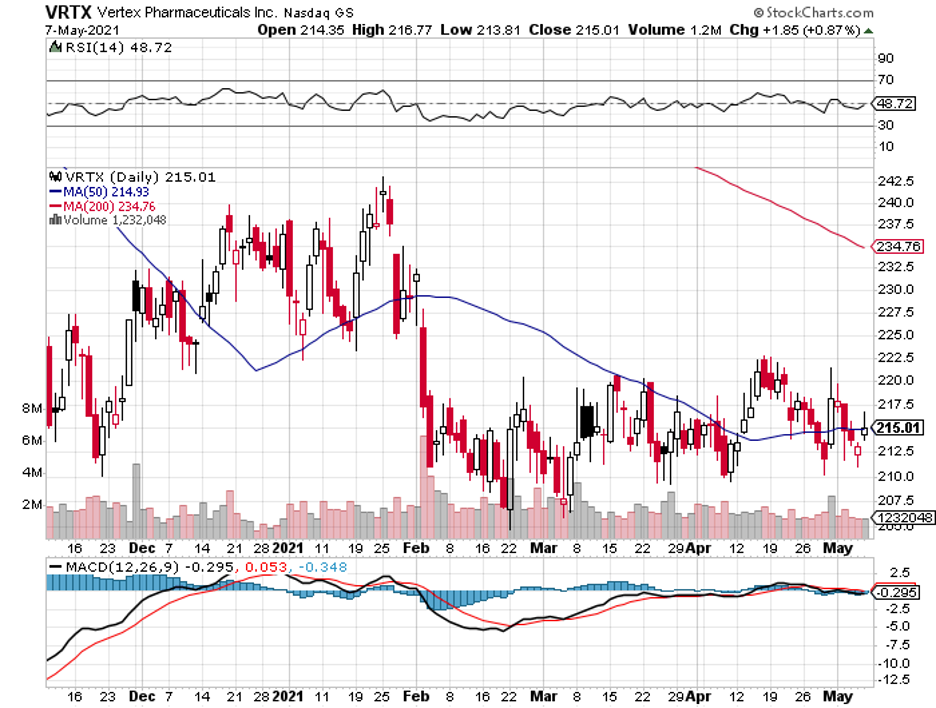Despite the exceptional performance of a handful of biotechnology companies, many healthcare stocks have languished over the course of the last 12 months due to the extra costs and added uncertainty brought by the COVID-19 pandemic.
Amid its continuous success for almost a decade, with shares climbing by over 800% from 2012 to mid-2020 and outpacing the S&P 500 nearly four times over, Vertex Pharmaceuticals (VRTX) stock was not spared during this turbulent period.
In fact, shares of the company fell by roughly 25% in mid-October following their decision to cancel the development of VX-814.
This once-promising drug, which was initially expected to treat a genetic disorder affecting the liver and kidney, showed disappointing results in its trials last year.
Despite falling out of favor with investors, I think this $55.66 billion-by-market-capitalization biotechnology company holds a strong track record and remains a compelling buy—a fact proven by its first quarter earnings report.
Vertex recorded $1.72 billion in revenue for the first quarter of 2021, showing off a 14% year-over-year jump and topping the projected estimate from analysts of $1.66 billion.
The company also reported a notable improvement on its bottom line, with an adjusted net income of $781 million or $2.98 per share.
In comparison, Vertex recorded $674 million in earnings or $2.56 per share during the same period in 2020.
This embattled biotechnology company marked the end of the first quarter with a total of $6.9 billion in cash, cash equivalents, and marketable securities, exhibiting a $265 million increase from the end of 2020.
Although Vertex anticipates a slowdown in its revenue growth this year, it still projects a full-year sale in the range of $6.7 billion and $6.9 billion.
To see if this is realistic, let’s take a look at the company’s current drug portfolio.
The core of Vertex’s business is its cystic fibrosis (CF) lineup. Without treatment, this disease could lead to the early death of patients.
At the moment, Vertex has four approved CF drugs out in the market: Kalydeco, Orkambi, Symdeko, and Trikafta.
With the extent of patient profiles that these four drugs cover, Vertex has virtually cornered the CF market and established a monopoly.
To date, roughly 50% of cystic patients in the US, Australia, Canada, and Europe are treated using Vertex drugs.
Among the four, Trikafta appears to have the potential to become a blockbuster.
Trikafta is forecasted to take the lion’s share in the CF market in the next few years, with its revenue rising from $3.8 billion to $8.9 billion by 2026. This would translate to a growth in Vertex’s CF program from $6.2 billion to $9.6 billion.
While skeptics might assume that the growth projection is too high, it’s important to remember the trajectory of the Trikafta-Kaftrio drug.
The revenue of this combo grew from $420 million in 2019 to a whopping $3.86 billion in 2020.
Given that CF has become a lucrative market, it no longer comes as a surprise that competitors are starting to swarm the space.
Vertex’s biggest rival in the space so far is AbbVie (ABBV), which has been working on triple combinations of its own drugs.
Apart from its CF programs, Vertex’s pipelines also serve as catalysts for its growth.
Although VX-814 failed and caused the company’s shares to fall in 2020, Vertex has another candidate, VX-864, which has been showing more promising results as of late.
You might be wondering why Vertex insists on working on this drug despite the backlash it suffered last year. This is primarily rooted in the potential of the product.
VX-864, if successful, could be the next CF-like moneymaker for Vertex. By 2026, sales for this drug are estimated to reach $640 million and will peak by 2030 at $1.1 billion.
On top of these, Vertex has collaborated with CRISPR Therapeutics (CRSP) to develop gene therapy for sickle cell disease. So far, the treatment has received a fast-track designation from the FDA.
If approved, their drug, CTX-001, will directly compete with bluebird bio’s (BLUE) LentiGlobin.
The current pricing for bluebird’s therapy is $1.2 million.
To date, there are roughly 250,000 patients suffering from sickle cell disease in the US and Europe. Among them, 25% are diagnosed to be in the severe stages. This is the market that CTX-001 aims to target.
Using the pricing of LentiGlobin as the basis, CTX-001 has the potential to reach $1.6 billion in sales in 2026 and peak at $2 billion in 2029.
If the two companies succeed in this, then CTX-001 is another blockbuster drug added to Vertex’s portfolio.
Overall, Vertex is a good long-term investment stock. It has a proven track record and a healthy pipeline filled with promising candidates. I say you should take advantage and buy the dips.


